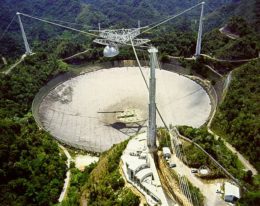Got any plans in 46 million years? If not, you should keep an eye out for PSR J1946+2052 around that time — this upcoming merger of two neutron stars promises to be an exciting show!
Survey Success

Average profile for PSR J1946+2052 at 1.43 GHz from a 2 hr observation from the Arecibo Observatory. [Stovall et al. 2018]
Today’s study, led by Kevin Stovall (National Radio Astronomy Observatory), goes to show that these surveys are doing a great job so far! Yet another double-neutron-star binary, PSR J1946+2052, has now been discovered as part of the Arecibo L-Band Feed Array pulsar (PALFA) survey. This one is especially unique due to the incredible speed with which these neutron stars orbit each other and their correspondingly (relatively!) short timescale for merger.
An Extreme Example
The PALFA survey, conducted with the enormous 305-meter radio dish at Arecibo, has thus far resulted in the discovery of 180 pulsars — including two double-neutron-star systems. The most recent discovery by Stovall and collaborators brings that number up to three, for a grand total of 16 binary-neutron-star systems (confirmed and unconfirmed) known to date.

The 305-m Arecibo Radio Telescope, built into the landscape at Arecibo, Puerto Rico. [NOAO/AURA/NSF/H. Schweiker/WIYN]
PSR J1946+2052 is a system of extremes. The binary’s total mass is found to be ~2.5 solar masses, placing it among the lightest binary-neutron-star systems known. Its orbital period is the shortest we’ve observed, and the two neutron stars are on track to merge in less time than any other known neutron-star binaries: in just 46 million years. When the two stars reach the final stages of their merger, the effects of the pulsar’s rapid spin on the gravitational-wave signal will be the largest of any such system discovered to date.
More Tests of General Relativity
What can PSR J1946+2052 do for us? This extreme system will be especially useful as a gravitational laboratory. Continued observations of PSR J1946+2052 will pin down with unprecedented precision parameters like the Einstein delay and the rate of decay of the binary’s orbit due to the emission of gravitational waves, testing the predictions of general relativity to an order of magnitude higher precision than was possible before.
As we expect there to be thousands of systems like PSR J1946+2052 in our galaxy alone, better understanding this binary — and finding more like it — continue to be important steps toward interpreting compact-object merger observations in the future.
Citation
K. Stovall et al 2018 ApJL 854 L22. doi:10.3847/2041-8213/aaad06

3 Comments
Pingback: binary neutron stars to merge
Pingback: February 26, 2018 | Colorado Space News
Pingback: PSR J1946+2052 – Engster bisher bekannter Doppelneutronenstern entdeckt – Alpha Cephei